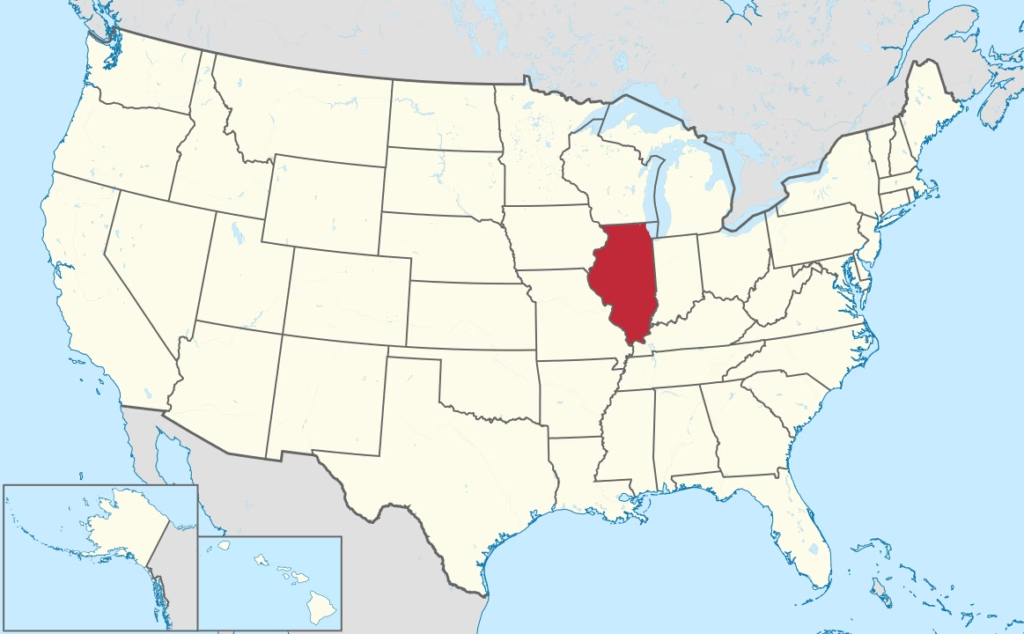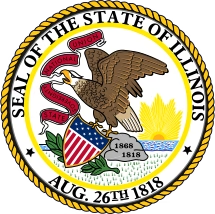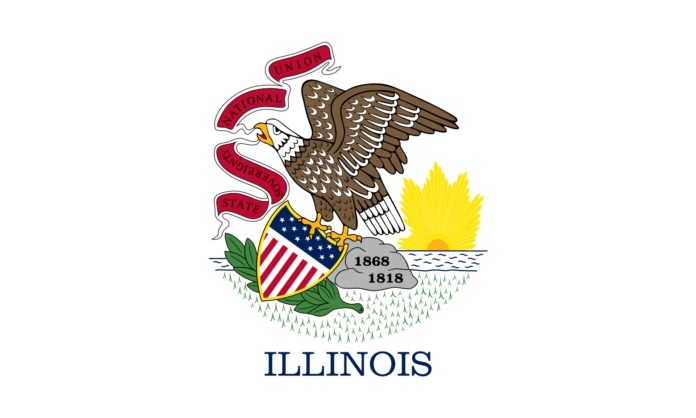Illinois, often called The Prairie State, is one of the most historically and economically significant states in the United States. Located in the heart of the Midwest, Illinois is known for its fertile farmland, bustling cities, cultural diversity, and pivotal role in American history. This article provides a comprehensive overview of Illinois, exploring its geography, history, population, economy, culture, and major cities, making it a perfect resource for high school students studying U.S. states.
Geographic Location and Physical Features of Illinois
Illinois is bordered by six states: Wisconsin to the north, Iowa and Missouri to the west, Kentucky to the southeast, Indiana to the east, and Michigan via Lake Michigan to the northeast. The state covers approximately 57,900 square miles, ranking 25th in size among U.S. states.
The geography of Illinois can be divided into three main regions:
- Northern Illinois – Home to Chicago and Lake Michigan, featuring urban landscapes and industrial centers.
- Central Illinois – Known for vast prairies and farmland, producing corn, soybeans, and other crops.
- Southern Illinois – Characterized by rolling hills, forests, and the confluence of the Mississippi and Ohio Rivers.
Illinois benefits from major waterways, including the Mississippi River, Illinois River, and Lake Michigan, which have played a crucial role in transportation, trade, and settlement patterns.
A Brief History of Illinois
Native American Heritage
Before European settlement, Illinois was inhabited by several Native American tribes, including the Illiniwek (from which the state gets its name), Potawatomi, Miami, and Sauk and Fox tribes. These communities thrived through hunting, agriculture, and trade.
French Exploration and Early Settlement
French explorers, including Jacques Marquette and Louis Jolliet, traveled through Illinois in the 1670s. The region became part of New France and later passed to British control before being ceded to the United States after the American Revolution.
Statehood
Illinois became the 21st state of the United States on December 3, 1818. Its strategic location and fertile land attracted settlers rapidly, and the state played a central role in westward expansion and trade.
Civil War Era and Beyond
Illinois was a free state during the Civil War and a key supporter of the Union. Notably, it was the home state of Abraham Lincoln, the 16th U.S. President, whose leadership preserved the Union.
Illinois State Symbols and Facts
- State Nickname: The Prairie State
- State Capital: Springfield
- Largest City: Chicago
- State Bird: Northern Cardinal
- State Flower: Violet
- State Tree: White Oak
- State Motto: “State Sovereignty, National Union”
These symbols reflect Illinois’s natural heritage, agricultural history, and role in the formation of the United States.
Population and Demographics
Illinois is one of the most populous states in the Midwest, with a population of approximately 12.8 million people. The population is highly diverse, especially in the Chicago metropolitan area, which is home to significant African American, Hispanic, Asian, and European-descendant communities.
Urbanization is a defining characteristic: nearly two-thirds of Illinois residents live in or near Chicago, the third-largest city in the United States.
Chicago: The Heart of Illinois
Chicago is not only the largest city in Illinois but also a cultural and economic powerhouse. Located on the shores of Lake Michigan, Chicago is known for its iconic skyline, architectural innovation, and vibrant arts scene. The city has a rich history of immigration, industry, and cultural development.
Key attractions in Chicago include:
- Willis Tower (formerly Sears Tower) – One of the tallest buildings in the Western Hemisphere.
- Millennium Park – Home to the famous “Cloud Gate” sculpture.
- Navy Pier – A hub for entertainment and tourism.
- The Art Institute of Chicago – One of the oldest and largest art museums in the U.S.
Chicago is also a major center for finance, technology, and education, housing institutions such as the University of Chicago and Northwestern University.
Economy of Illinois
Agriculture
Illinois is one of the top agricultural states in the U.S. Its fertile soil and favorable climate make it ideal for growing corn and soybeans, which are the state’s two leading crops. Livestock farming, especially cattle and hogs, is also important.
Industry and Manufacturing
Illinois is a leader in manufacturing, producing machinery, chemicals, food products, and electronics. Chicago has historically been a center for meatpacking and continues to be a hub for food processing.
Finance and Technology
Chicago is a major financial center, home to the Chicago Board of Trade and the Chicago Mercantile Exchange. In recent years, the state has seen growth in technology, startups, and green energy initiatives.
Transportation and Trade
Illinois is sometimes called the “Transportation Hub of America” because of its extensive network of railroads, highways, and airports. O’Hare International Airport in Chicago is one of the busiest airports in the world.
Education and Higher Learning in Illinois
Illinois is home to several world-renowned universities and colleges, including:
- University of Illinois Urbana-Champaign – A leading public research university.
- Northwestern University – Known for law, journalism, and engineering programs.
- University of Chicago – Famous for economics, political science, and its Nobel Prize-winning faculty.
- Illinois State University – The state’s oldest public university.
These institutions contribute to Illinois’s reputation as a center for innovation and intellectual growth.
Culture and Arts in Illinois
Illinois has a rich cultural landscape shaped by its diverse population. Chicago is particularly known for its contributions to music, including blues, jazz, gospel, and house music. The state also has a thriving theater scene, with Chicago’s Second City comedy troupe serving as a launching pad for many famous comedians.
Annual events and festivals include:
- Chicago Blues Festival
- Taste of Chicago – A large food festival highlighting the city’s culinary diversity.
- Illinois State Fair in Springfield
- Chicago Air and Water Show
Illinois’s cultural heritage also includes important landmarks such as Route 66, which begins in Chicago and symbolizes American travel and history.
Tourism and Natural Attractions
Beyond Chicago, Illinois offers numerous natural and historical attractions:
- Shawnee National Forest – Located in Southern Illinois, known for scenic trails and rock formations like Garden of the Gods.
- Starved Rock State Park – Popular for hiking, waterfalls, and canyons.
- Mississippi River Scenic Byway – Offers beautiful river views and historic towns.
- Lincoln Home National Historic Site – Preserves Abraham Lincoln’s home in Springfield.
Illinois’s combination of urban and rural landscapes makes it a versatile state for tourism and education.
Interesting Facts About Illinois
- Illinois was the first state to ratify the 13th Amendment abolishing slavery.
- The first skyscraper in the world was built in Chicago in 1885.
- Illinois has more than 1,200 miles of interstate highways, earning its title as a transportation hub.
- The Chicago River is famously dyed green every St. Patrick’s Day.
- Springfield is home to the largest collection of Abraham Lincoln historical sites.
Why Study Illinois?
For high school students, Illinois provides a unique perspective on U.S. history, economics, and culture. It was a launching point for Abraham Lincoln’s political career, a center of industrial growth, and a hub for immigration and cultural diversity.
Studying Illinois allows students to see how agriculture, urbanization, and transportation infrastructure contribute to a state’s development. It also highlights the importance of cultural heritage, music, and arts in shaping national identity.
Conclusion
Illinois stands as a microcosm of the United States: diverse, innovative, and historically significant. From the bustling streets of Chicago to the peaceful prairies of Central Illinois and the rolling hills of the south, the Prairie State offers a wealth of knowledge for students exploring U.S. geography and history.
With its rich agricultural traditions, industrial power, cultural influence, and historical significance, Illinois is more than just a state—it is a cornerstone of the American story. For students learning about the 50 states, Illinois serves as an essential chapter in understanding the nation as a whole.



